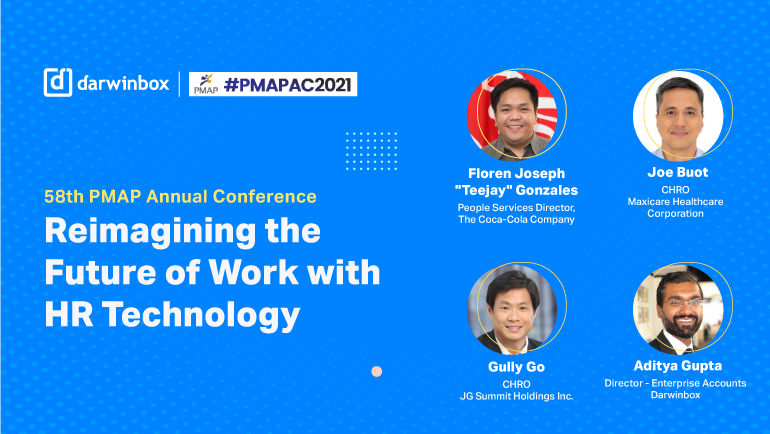

We know that life has changed, and we know why. We dare not say that word again.
But the show, as they say, must go on, and indeed it has gone on. In many ways, we are already living the future of work.
The world has been flirting with the concept of work-from-home for years, paying lip service to it, but everyone was forced to do it in 2020. This may have already been partially a practice with the IBMs, Intels, Accentures, and other MNCs of the world, but for more homegrown companies across Southeast Asia, and especially in the Philippines, it was a tough pill to swallow.
And yet companies have not only done it, they are even thriving in the new normal. We spoke to leaders of some of the biggest companies in the Philippines about what organizations need to do embrace the future of work and reimagine it using HR technology.
The event was hosted by Darwinbox in association with the People Management Association of the Philippines, and we spoke with Sir Floren Joseph "Teejay" Gonzales, People Services Director, Coca-Cola Bottling Investments Group; Sir Gully Go, Chief Human Resources Officer, JG Summit Holdings Inc. and Sir Joe Buot, Chief HR Officer, Maxicare Healthcare Corporation; moderated by Aditya Gupta, Director of Enterprise Accounts, Darwinbox.
The fundamental pillars of the future of work
The scenario of 2020 taught all of us one thing: in this hyperconnected, ultra-modern world, anything can happen. We can’t even predict when the next crisis—or on a more positive note, the next breakthrough—might come or what it might be.
Faced with the reality of a highly volatile and unpredictable future, one thing that all the HR stalwarts on our panel agreed on was that the ability of an organization to be future-ready came down to its VALUES, and the organizational leadership that employees experience.
Things will need to change, as Sir Gully pointed out. “J.G. Summit has seven different sectors with a common purpose: an unrelenting commitment to provide better choices for our customers,” he said. “First we had to strengthen our identity.
“Second, values have to have a tangible, operational aspect. So structures need to be redesigned, mandates need to be reviewed. Agility is a must, and if you look at how we’re set up you can see how quickly our retail and FMCG sectors moved beyond the crisis.
“Third, we have to make bolder ecosystem plays. Now, ours is a huge ship, and to turn it around is not easy. You have to talk to many talented CEOs and leadership positions in the market. It’s about constructing a coalition that can enable things to scale.”
Sir Joe Buot emphasized that it is critical to lead with values and ensure we have a robust foundation, because that will serve as the core of the identity of your organization. He tells that in Maxicare, meetings with senior management now have an entire hour devoted to asking ‘how we deepen our values’ before getting into other aspects of business.
Critical areas to focus on for the future of work
“No one has textbook on covid,” points out Sir Teejay, “we will have to craft our own way to do business.”
This involves plenty of listening to the workforce.
A lot of waxing eloquent about the boons of work-from-home has been done, but perhaps surprisingly (nor maybe not), Sir Gully finds that 76% of the J.G. Summit workforce are willing to come back to office for a few days a week, because they miss the interaction and culture building. Sir Teejay says in Coca-Cola there are plans to reconfigure and redesign things so that people can get back sooner.
Sir Gully says, “They call office ‘the new offsite’ these days, because coming to the office is like an event in itself. So, we need to focus on moments of connection.”
Companies are also increasingly focusing on what they do for the good of the country. J.G. Summit, for example, is providing hotels for quarantine, and changing how they look at cargo for the shipment of vaccines. Everyone is in the same boat, and organizations who can, must show leadership by being part of the bigger solution to society’s problems.
And finally, we need to look at how we communicate. Newsletter, multiple town halls, 1-on-1s, or whatever else, the idea is to communicate, communicate, communicate.
Sharp focus on employee wellness
Sir Joe threw light on the need for companies to take a holistic view of performance. He talked about how Maxicare is looking at combining performance management with health and wellness. For the future of work, organizations will have to not only preach but also prioritize the health and wellness of the workforce.
Right now when you see employee feedback, they are crying out loud for health and wellness programs. How will the company take care of the employees? Well, it has to cover physical, mental, and financial well-being,” says Sir Joe.
Maxicare undertook a number of initiatives for this. One was arranging wellness sessions via MaxiLife. Another was encouraging employees to maintain wellness journals. But to really drive this as a culture, it was made part of their performance evaluation KRAs. Initially it was 5% or their overall score, then grew to 10%.
At first, there were concerns around this, but the team took a pragmatic approach and methodologically arrived at metrics which involved input from annual checkups, submission of health journals, and attendance of company health and wellness programs, just to name a few.
For now, “Proof of attendance of even 50% of MaxiLife programs is good enough to meet expectations. And now we see people doing their own health and wellness journals without us driving it. Would like to sustain this behavior,” says Sir Joe.
Supercharge talent discovery in a distributed set up
In the future of work, we will need to identify tomorrow’s leaders from within our ranks remotely. But we are moving from Zoom meeting to Zoom meeting, and that’s often the end of interaction. It is difficult to get the granular data on who’s performing that we used to get by virtue of just being in the same place.
Sir Gully points out that goal-setting is key in this process, but many time we end up just filling in those goals at evaluation time because we have to.
J.G. Summit has started to link the goals of the CEO all the way to the last person. It’s easier said than done; it involves a lot of realignment and recalibration, which falls to HR. And there is no perfect way to do it.
Ultimately, says Gully, “We have to see where the checkpoints and conversations are, and where HR tech comes in. Whenever I have a conversation with a -1, I turn to Darwinbox and put notes in it. If I leave these conversations in Whatsapp or email, I lose fidelity, I can’t just go back to my TA and ask what I said that time with so-and-so?”
Sir Gully points out that it’s not even high-tech, but very impactful. It’s a matter of taking a performance conversation and capturing it so the evidence is always there. And it’s not only conversations between a manager and reportee, but among colleagues as well. All of this helps an individual see how they will contribute to an organization, and Darwinbox unifies all of it.
But to work, it first has to have the trust of the employees; they have to see that it is not being misused, and that it is in fact working for their own betterment.
Aditya Gupta from Darwinbox was able to share insight on how firms across the region are re-imagining performance management. Firms like Fave are strengthening values by using very creative Rewards for their employees and associates. Firms such as STP in Indonesia are pushing the envelope on continuous feedback— they did 20,000+ continuous feedbacks in a month with 500 employees. Aditya also shared how firms such as JG summit and Tokopedia were exploring ways of leveraging the platform to re-imagine performance management to bring a sharp focus not only on “what was achieved” (goal conversations, OKR vs. MBO) but also “how it was achieved” (multi-stakeholder feedback, coaching conversations).
The future of work needs to be fun
At last, we cannot forget that “the new normal” doesn’t need to be this big, scary thing. Yes, there are serious matters that need to be taken care of but work still needs to be fun.
Sir Gully talked about the need to be distracted from tunnel vision of work. HR at J.G. Summit has accelerated the creation of interest groups, some places for colleagues to jam on common interests.
Sir Joe asked the question, “How do we really embed fun at work?”
Employees are longing for the good old days. They miss the simple things, like going to lunch, or Friday evening outings.
As HR practitioners who want to lead with values, we must never forget empathy.
“We even tried to make the vaccination drive fun,” said Sir Joe. “It was a chance for colleagues to see each other after 15 or 16 months. It may have started as a vaccination program, but in the end, it became an engagement activity. There was even one employee who was about to leave, but then decided to stay just because she got to see her colleagues.”
The challenges ahead are layered. HR teams will need to simultaneously address multiple aspects. There is bound to be setbacks as we learn our way forward, but we will all get better. Remember, there is no textbook for this new paradigm.
But with your foundational values as your guard rails, and powerful HR tech as an enabler, we can certainly work with confidence towards ensuring the future of work is a bright place.
You can check out everything that was discussed in full by accessing the webinar here.



Speak Your Mind